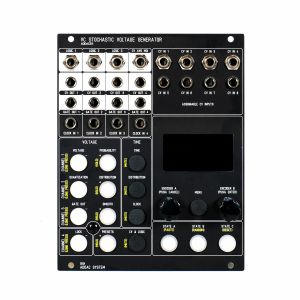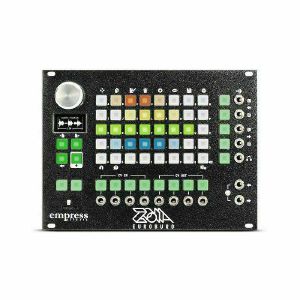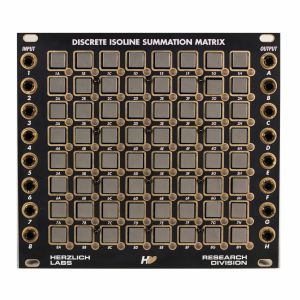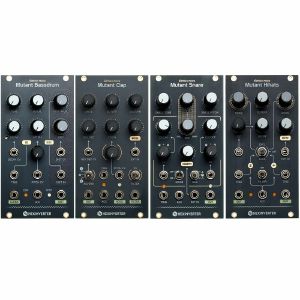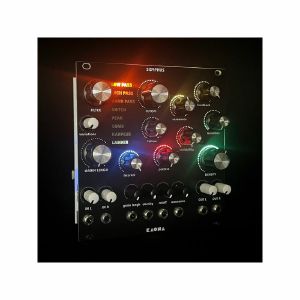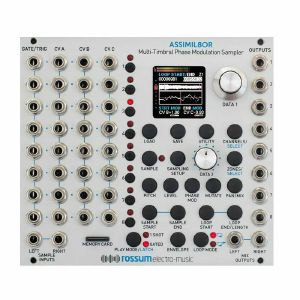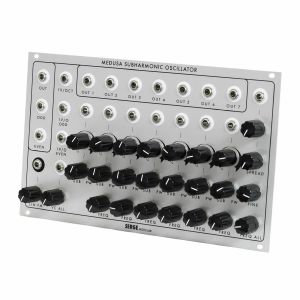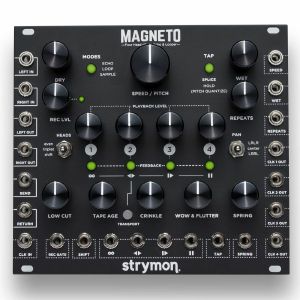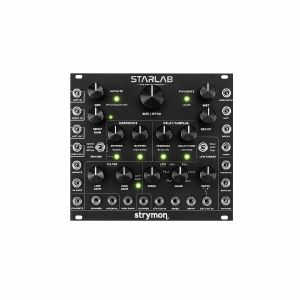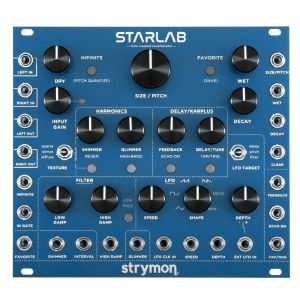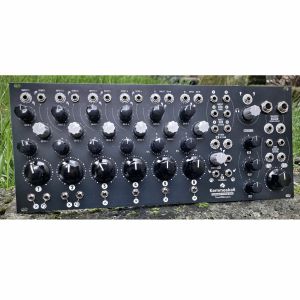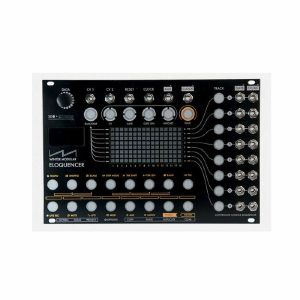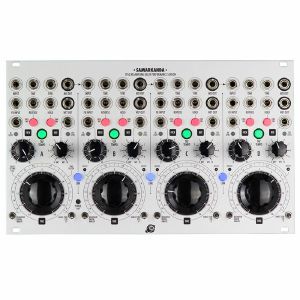Filter
シンセ・モジュール
The Eurorack modular synth format is one of the most exciting areas of music technology. Pioneered by Doepfer, there are now hundreds of brands offering compatible modules of all varieties. You can combine your choice of the best oscillators, filters and much more in order to create a unique, bespoke synth setup which perfectly suits your needs.
Eurorack modules offer the biggest range of options you can imagine, from basic analogue modules which replicate the sound of classic vintage synths, through to digital modules which allow you to explore completely new approaches to making music.
Whether you’re a beginner or a more experienced modular head, you can take your pick of the best modules from leading brands including Mutable Instruments and ALM Busy Circuits.
Our range also includes accessories, cases, patch cables and much more, allowing you to build and customise your perfect modular synth setup.

1~13/13(ページ1/1)の商品
ADDAC System ADDAC511 VC Stochastic Voltage Generator Module (voltage generator synth module)
Cat: 1080319 Rel: 08 May 25
This is a fully fledged 4 channel voltage generator capable of all things random, with quantization, probability, distribution, interpolation, time control, clock, states and a 32 step sequencer
Notes: Based on the ADDAC501 Complex Random module, the 511 expands the concept to become an even more powerful random/stochastic voltage generator. Four channels, all capable of being used for envelopes, modulation sources, sequencers and much more.
Supplier's Notes:
This module greatly expands on the principles of the ADDAC501 Complex Random from 2013.
This is a fully fledged 4 channel voltage generator capable of all things random, with quantization, probability, distribution, interpolation, time control, clock, states and a 32 step sequencer.
The module operation relies on its screen for all parameter editing, each button accesses one single page where parameters can be changed allowing a fast and fluid workflow across all settings.
Long presses on all buttons have a secondary function allowing fast Channel selection plus Mute and Hold functions.
The combination of having 2 Encoders with Push buttons allow swift navigation and editing across all pages and their settings.
Tech Specs:
20HP
4.5cm deep
200mA +12V
100mA -12V
… Read moreSupplier's Notes:
This module greatly expands on the principles of the ADDAC501 Complex Random from 2013.
This is a fully fledged 4 channel voltage generator capable of all things random, with quantization, probability, distribution, interpolation, time control, clock, states and a 32 step sequencer.
The module operation relies on its screen for all parameter editing, each button accesses one single page where parameters can be changed allowing a fast and fluid workflow across all settings.
Long presses on all buttons have a secondary function allowing fast Channel selection plus Mute and Hold functions.
The combination of having 2 Encoders with Push buttons allow swift navigation and editing across all pages and their settings.
Tech Specs:
20HP
4.5cm deep
200mA +12V
100mA -12V
2 in stock $622.67
Click for better price!
or call +44 20 7424 1960
quote 1080319
quote 1080319
Empress Effects Zoia Euroburo Synth Voice Module (B-STOCK) (CV modulation/effect/synth voice/utility synth module)
Cat: 1079706 Rel: 01 Jan 90
B-STOCK: Item refurbished, repaired and in perfect working order.
Notes: ***B-STOCK: Item refurbished, repaired and in perfect working order.***
Endlessly customisable digital 'modular system within a modular system'. Includes more than 80 modules, allowing you to create effects, synths, control devices, oscillators, filters and much more.
Supplier's Notes:
What's a Euroboro?
The ZOIA Euroburo is a digital modular system that can be placed in your modular system, a real Russian nesting doll situation. We added a headphone output and a super-slim optional case so the Euroburo can live happily on your desktop or be easily mounted in a Eurorack case. Hence the euro + buro, pronounced "bureau"...get it!?
Create unique signature effects, synthesizers, sequencers and more while using 4 freely assignable CV ins and 4 outs to interface with other CV enabled devices. The additional headphone output and powered 9v case makes the module even more desktop friendly. With over 90 modules from CV utilities to audio effects, oscillators and envelopes to MIDI, the Euroburo can do almost anything to fill the gaps in your setup.
There's no need to worry about getting bogged down with endless menus or a cluttered interface. Creating patches and performing with the ZOIA is a tactile experience. Patching, deleting or moving modules and editing values can all be done quickly using the push-button grid and a flick of the encoder. With the addition of dedicated push buttons for the CV and Audio I/O, patching on the ZOIA has never been faster.
… Read moreEndlessly customisable digital 'modular system within a modular system'. Includes more than 80 modules, allowing you to create effects, synths, control devices, oscillators, filters and much more.
Supplier's Notes:
What's a Euroboro?
The ZOIA Euroburo is a digital modular system that can be placed in your modular system, a real Russian nesting doll situation. We added a headphone output and a super-slim optional case so the Euroburo can live happily on your desktop or be easily mounted in a Eurorack case. Hence the euro + buro, pronounced "bureau"...get it!?
Create unique signature effects, synthesizers, sequencers and more while using 4 freely assignable CV ins and 4 outs to interface with other CV enabled devices. The additional headphone output and powered 9v case makes the module even more desktop friendly. With over 90 modules from CV utilities to audio effects, oscillators and envelopes to MIDI, the Euroburo can do almost anything to fill the gaps in your setup.
There's no need to worry about getting bogged down with endless menus or a cluttered interface. Creating patches and performing with the ZOIA is a tactile experience. Patching, deleting or moving modules and editing values can all be done quickly using the push-button grid and a flick of the encoder. With the addition of dedicated push buttons for the CV and Audio I/O, patching on the ZOIA has never been faster.
1 in stock $774.20
Herzlich Labs Discrete Isoline Summation Matrix 8x8 Matrix Mixer Module (mixer synth module)
Cat: 1064004 Rel: 06 Feb 25
Summing mixer with up to eight inputs per output
Notes: Extremely versatile signal routing is the name of the game here. Eight inputs and eight outputs are connected via the matrix, allowing you to route and mix audio, CV, triggers and gates via the buttons.
Supplier's Notes:
Like four 4x4 Switch Matrix set side by side, the Discrete Isoline Summation Matrix is a true matrix mixer powerhouse, a mad dream and an science experiment gone too far all in one.
As the name implies, the unit contains eight individual inputs and outputs, all of which can be individually routed by way of the isolinear switch matrix on the front panel. Inputs are arranged in rows, while outputs are assigned to columns, making it easy and intuitive to quickly route any given input to any given output. All inputs and outputs are individually buffered, and each mechanical switch offers both tactile and visual feedback in the form of a soft, audible click as well as a connected LED turning on or off to indicate the state of the current junction.
Like it's predecessor, the 4x4 Switch Matrix, the Discrete Isoline Summation Matrix is a DC coupled summing mixer, allowing both CV and audio to be mixed interally, with virtuous or disastrous results.. Finally, the unit is compact at only 28hp, and pairs perfectly with the Qatt quad attenuator, Stum quad mute and 180- quad inverter for greater control over your inputs and outputs.
You already know what you are going to be doing with this - whether your plan is to mix an ungodly amount of CV, create an incredible amount of new trigger patterns, have a massive FX routing setup, or some manner of unspeakable matrix mixer situation on your hands, you will be armed to the teeth with the Discrete Isoline Summation Matrix.
… Read moreSupplier's Notes:
Like four 4x4 Switch Matrix set side by side, the Discrete Isoline Summation Matrix is a true matrix mixer powerhouse, a mad dream and an science experiment gone too far all in one.
As the name implies, the unit contains eight individual inputs and outputs, all of which can be individually routed by way of the isolinear switch matrix on the front panel. Inputs are arranged in rows, while outputs are assigned to columns, making it easy and intuitive to quickly route any given input to any given output. All inputs and outputs are individually buffered, and each mechanical switch offers both tactile and visual feedback in the form of a soft, audible click as well as a connected LED turning on or off to indicate the state of the current junction.
Like it's predecessor, the 4x4 Switch Matrix, the Discrete Isoline Summation Matrix is a DC coupled summing mixer, allowing both CV and audio to be mixed interally, with virtuous or disastrous results.. Finally, the unit is compact at only 28hp, and pairs perfectly with the Qatt quad attenuator, Stum quad mute and 180- quad inverter for greater control over your inputs and outputs.
You already know what you are going to be doing with this - whether your plan is to mix an ungodly amount of CV, create an incredible amount of new trigger patterns, have a massive FX routing setup, or some manner of unspeakable matrix mixer situation on your hands, you will be armed to the teeth with the Discrete Isoline Summation Matrix.
1 in stock $706.72
Click for better price!
or call +44 20 7424 1960
quote 1064004
quote 1064004
Hexinverter Mutant Snare/Hi-Hats/Clap/Bassdrum Modules Bundle (edition noire) (drum synth module bundle)
Cat: 1072385 Rel: 27 Feb 25
Analog drum modules iterating upon classic 808 & 909 drum sounds.
Notes: Black edition of Hexinverter's 808-inspired drum bundle. Kick, clap, snare and hat modules recreate the iconic sounds of Roland's legendary analogue drum machine, all updated with modular features.
Supplier's Notes:
Introducing four re-issues of classic Hexinverter drum modules - the Mutant Bass Drum, Mutant Snare, Mutant Clap and Mutant Hihats! These modules are perfect for anyone with a taste for classic TR808/909 sounds, but with a greatly expanded tonal range with voltage control over parameters and, of course, optional high distortion!
… Read moreSupplier's Notes:
Introducing four re-issues of classic Hexinverter drum modules - the Mutant Bass Drum, Mutant Snare, Mutant Clap and Mutant Hihats! These modules are perfect for anyone with a taste for classic TR808/909 sounds, but with a greatly expanded tonal range with voltage control over parameters and, of course, optional high distortion!
2 in stock $662.50
Kaona Sisyphus Multi-Filter/Multi-Grain Granular Filter Module (filter synth module)
Cat: 1072928 Rel: 24 Mar 25
Versatile granular filter that allows multiple grains in one audio stream
Notes: Super versatile granular filtering. Incoming sounds are granulated, then processed with eight contrasting filters. Hands-on and CV controls allow you to manipulate and modulate the output.
Supplier's Notes:
Sisyphus is built around a granular engine and a palette of eight original filters. Its granular system allows multiple grains to coexist within a single stereo audio stream, where they combine and interact with each other.
This filter is based on a comprehensive granular approach to sound: rather than a granular engine followed by a filter, it offers true integration of filtering into the grain-generation process. Each generated grain carries the filtering characteristics defined by the musician and will be combined with other grains according to evolving, configurable patterns.
These filters have been developed entirely from scratch in-house, without using typical filter libraries, so they each have their own unique color for you to explore!
Filters
Lowpass: Attenuates high frequencies above the cutoff frequency. 12 dB/oct slope.
Highpass: Attenuates low frequencies below the cutoff frequency. 12 dB/oct slope.
Bandpass: Lets through a band of frequencies around the cutoff frequency. 12 dB/oct slope.
Notch: Dips around the cutoff frequency while letting the rest of the spectrum pass through.
Peak: Boosts the band around the cutoff frequency while allowing the rest of the spectrum to pass without a drastic cut.
Comb: Creates a series of cancellations and resonances based on an internal delay and feedback.
Karplus (Karplus-Strong: Simulates the vibration of a string or looping resonance by combining a short delay, feedback, and damping.
Ladder: Inspired by Moog-style analogue filters, with four stages in cascade. Features a steep slope (24 dB/oct) and a distinctive resonance that can reach self-oscillation.
Filter Controls
Cutoff (Cutoff Frequency):Defines the filter's cutoff frequency or center frequency (depending on filter type), ranging from 10 Hz to 20 kHz.
Resonance: Emphasises frequencies near the cutoff frequency, from a slight bump up to the edge of self-oscillation.
Feedback: Re-injects part of the output back into the filter input.
Variations: Introduces an instability in the setting of the cutoff frequency, resonance, or feedback (depending on the selected filter), allowing for a more or less "organic" filter character.
Grain Controls: The incoming sound is continuously sampled and segmented into buffers. Each segment is analysed, filtered, and then extracted to become a grain. You can change the length of each grain, the interval between grains, the way grains follow one another, how they are arranged in relation to each other, and their density (number and influence).
Grain Length: Adjusts the length of the audio grains. The shorter the grains, the more the sound fragments into a "grained" granular texture; the longer the grains, the closer the result is to the original sound, but filtered and delayed. When multiple grains are played simultaneously, longer grains make echo effects more noticeable.
Grain Interval: Determines the time between the start of two successive grains (or the probability of automatic triggering).
Pattern: Grains are organized according to predefined, adjustable patterns. Several scenarios allow you to explore different ways grains can combine, from highly organized to more chaotic.
Density: Determines how many grains are played simultaneously and their intensity.
Variability: Sets the magnitude of the special effects specific to each pattern.
Transition: Defines the shape of the envelope applied to the grains as they link together.
Input and Output: Sisyphus works with two parallel channels that share the same settings. You can use it either in stereo mode or as two separate mono audio channels.
CV Inputs: Four CV inputs allow control of Sisyphus using other Eurorack modules. These inputs accept the standard Eurorack voltages (0 to 8 V).
The four basic parameters that can be controlled via CV are: Grain Length, Density, Cutoff, and Resonance.
However, you can configure the module differently using an external file on an SD card. In that case, any CV input can be assigned to any control, the input voltage range (from 1 to 8 V) can be set, LED brightness can be adjusted, and more.
Specifications
Width: 24 HP
Power Consumption:
+12 V: 200 mA
-12 V: 10 mA
+5 V: 0 mA
Depth: 28 mm
Carefully built in France, with all potentiometers bolted to the front panel, and shipped in a metal storage box.
Power cable and knurlies included.
… Read moreSupplier's Notes:
Sisyphus is built around a granular engine and a palette of eight original filters. Its granular system allows multiple grains to coexist within a single stereo audio stream, where they combine and interact with each other.
This filter is based on a comprehensive granular approach to sound: rather than a granular engine followed by a filter, it offers true integration of filtering into the grain-generation process. Each generated grain carries the filtering characteristics defined by the musician and will be combined with other grains according to evolving, configurable patterns.
These filters have been developed entirely from scratch in-house, without using typical filter libraries, so they each have their own unique color for you to explore!
Filters
Lowpass: Attenuates high frequencies above the cutoff frequency. 12 dB/oct slope.
Highpass: Attenuates low frequencies below the cutoff frequency. 12 dB/oct slope.
Bandpass: Lets through a band of frequencies around the cutoff frequency. 12 dB/oct slope.
Notch: Dips around the cutoff frequency while letting the rest of the spectrum pass through.
Peak: Boosts the band around the cutoff frequency while allowing the rest of the spectrum to pass without a drastic cut.
Comb: Creates a series of cancellations and resonances based on an internal delay and feedback.
Karplus (Karplus-Strong: Simulates the vibration of a string or looping resonance by combining a short delay, feedback, and damping.
Ladder: Inspired by Moog-style analogue filters, with four stages in cascade. Features a steep slope (24 dB/oct) and a distinctive resonance that can reach self-oscillation.
Filter Controls
Cutoff (Cutoff Frequency):Defines the filter's cutoff frequency or center frequency (depending on filter type), ranging from 10 Hz to 20 kHz.
Resonance: Emphasises frequencies near the cutoff frequency, from a slight bump up to the edge of self-oscillation.
Feedback: Re-injects part of the output back into the filter input.
Variations: Introduces an instability in the setting of the cutoff frequency, resonance, or feedback (depending on the selected filter), allowing for a more or less "organic" filter character.
Grain Controls: The incoming sound is continuously sampled and segmented into buffers. Each segment is analysed, filtered, and then extracted to become a grain. You can change the length of each grain, the interval between grains, the way grains follow one another, how they are arranged in relation to each other, and their density (number and influence).
Grain Length: Adjusts the length of the audio grains. The shorter the grains, the more the sound fragments into a "grained" granular texture; the longer the grains, the closer the result is to the original sound, but filtered and delayed. When multiple grains are played simultaneously, longer grains make echo effects more noticeable.
Grain Interval: Determines the time between the start of two successive grains (or the probability of automatic triggering).
Pattern: Grains are organized according to predefined, adjustable patterns. Several scenarios allow you to explore different ways grains can combine, from highly organized to more chaotic.
Density: Determines how many grains are played simultaneously and their intensity.
Variability: Sets the magnitude of the special effects specific to each pattern.
Transition: Defines the shape of the envelope applied to the grains as they link together.
Input and Output: Sisyphus works with two parallel channels that share the same settings. You can use it either in stereo mode or as two separate mono audio channels.
CV Inputs: Four CV inputs allow control of Sisyphus using other Eurorack modules. These inputs accept the standard Eurorack voltages (0 to 8 V).
The four basic parameters that can be controlled via CV are: Grain Length, Density, Cutoff, and Resonance.
However, you can configure the module differently using an external file on an SD card. In that case, any CV input can be assigned to any control, the input voltage range (from 1 to 8 V) can be set, LED brightness can be adjusted, and more.
Specifications
Width: 24 HP
Power Consumption:
+12 V: 200 mA
-12 V: 10 mA
+5 V: 0 mA
Depth: 28 mm
Carefully built in France, with all potentiometers bolted to the front panel, and shipped in a metal storage box.
Power cable and knurlies included.
2 in stock $564.05
Click for better price!
or call +44 20 7424 1960
quote 1072928
quote 1072928
Rossum Electro-Music Assimil8or Multi-Timbral Phase Modulation Sampler Module(silver) (B-STOCK) (sampling/CV modulation/digital/drum/dual/stereo/multiple/LFO synth module)
Cat: 1070448 Rel: 01 Jan 90
B-STOCK: Item refurbished, repaired and in perfect working order.
Notes: ***B-STOCK: Item refurbished, repaired and in perfect working order.***
***Now featuring Assimil8or Software Version 2.0! Available to download here: http://www.rossum-electro.com/products/assimil8or/
The ASSIMIL8OR is a CV/Gate-controllable sampler with eight independent channels. Each channel is not only its own voice, but also has a separate audio output and a gate/trigger and three CV inputs. Given ever get two sample inputs and main outputs. Thus, Stereo Sampling and playback is possible. Mixed operation of stereo or mono is possible and is limited only by the maximum number of eight channels or parts.
The ASSIMIL8OR works with high-quality 24-bit AD and DA converters. Internally, however, sample and bit rate for lo-fi sound can be lowered, the latter is even CV-controllable. The samples can also be otherwise manipulated in many ways. Thus, the phase of a sample via CV or a different sample can be modulated. Likewise, the loop points can be controlled and the sample can be traversed with CV control (scrubbing), whereby wavetable similar effects could be achieved. The following parameters can be addressed via the gate / trigger and CV inputs:
- Pitch
- Level
- Bit Depth
- Phase Modulation
- Pan
- Scrub
- Sample Start
- Sample Length
- Loop Start
- Loop Length
- Release Decay
Samples and presets are stored on an SD card, which is easily accessible plugged into the module front.
… Read more***Now featuring Assimil8or Software Version 2.0! Available to download here: http://www.rossum-electro.com/products/assimil8or/
The ASSIMIL8OR is a CV/Gate-controllable sampler with eight independent channels. Each channel is not only its own voice, but also has a separate audio output and a gate/trigger and three CV inputs. Given ever get two sample inputs and main outputs. Thus, Stereo Sampling and playback is possible. Mixed operation of stereo or mono is possible and is limited only by the maximum number of eight channels or parts.
The ASSIMIL8OR works with high-quality 24-bit AD and DA converters. Internally, however, sample and bit rate for lo-fi sound can be lowered, the latter is even CV-controllable. The samples can also be otherwise manipulated in many ways. Thus, the phase of a sample via CV or a different sample can be modulated. Likewise, the loop points can be controlled and the sample can be traversed with CV control (scrubbing), whereby wavetable similar effects could be achieved. The following parameters can be addressed via the gate / trigger and CV inputs:
- Pitch
- Level
- Bit Depth
- Phase Modulation
- Pan
- Scrub
- Sample Start
- Sample Length
- Loop Start
- Loop Length
- Release Decay
Samples and presets are stored on an SD card, which is easily accessible plugged into the module front.
1 in stock $895.86
Serge Medusa Subharmonic Oscillator Module (oscillator synth module)
Cat: 1058366 Rel: 07 Mar 25
Serge Modular's take on a cluster generator, featuring 7 accurate analogue VCOs
Notes: The Subharmonic Oscillator is one of Serge's latest inventions and also one of his most extraordinary designs. 7 accurate analogue VCOs tied at the waist- in unison, yet their frequencies can open up like a fan, creating complex clusters. Each voice generates a pulse wave. It is temperature compensated and follows exceptional 1V/Octave tracking.
In addition, each voice provides (voltage controlled) pulse width modulation or subharmonic division as well as an individual output. The precision of these voices in combination with a global Spread control and various FM inputs opens up an enormous sonic range from massive unisono sounds to dissonant, orchestra-style textures.
The ODD and EVEN outputs enable the use as a stereo oscillator.
MEDUSA for eurorack:
Original Serge 2023 design
100% analogue
Eurorack format (3U), 42 hp
Power consumption: 220mA @ +12V, 200mA @ -12V
Skiff-friendly: < 25mm (1")
… Read moreIn addition, each voice provides (voltage controlled) pulse width modulation or subharmonic division as well as an individual output. The precision of these voices in combination with a global Spread control and various FM inputs opens up an enormous sonic range from massive unisono sounds to dissonant, orchestra-style textures.
The ODD and EVEN outputs enable the use as a stereo oscillator.
MEDUSA for eurorack:
Original Serge 2023 design
100% analogue
Eurorack format (3U), 42 hp
Power consumption: 220mA @ +12V, 200mA @ -12V
Skiff-friendly: < 25mm (1")
2 in stock $856.03
Strymon Magneto Tape Delay Module (tape delay module)
Cat: 1061145 Rel: 22 Jan 25
Tape delay module that can double as a looper, phrase sampler, spring reverb and more
Notes: Packed with powerful features while maintaining intuitive playability, Strymon's Magneto module is a stereo multi-head tape delay that also functions as a looper, phrase sampler, vintage spring reverb unit, phase-aligned clock multiplier, chaotic oscillator, zero latency sub-oscillator and more, with extensive CV I/O.
Turn simple monophonic signals into complex orchestrations. Create new oscillator tones using self-oscillation. Add rich stereo dimension to your sound, and enjoy the inherent warmth and sweet, subtle distortion characteristics of magnetic tape. Magneto transforms even the smallest rack into a fully expressive, immersive instrument.
To capture the full experience and complexity of a vintage tape echo machine, every last tape system attribute was relentlessly studied and faithfully recreated. From the sought-after natural saturation and soft clipping of magnetic tape when driven hard, to hands-on real-time controls for tape age, tape crinkle, and mechanical wow and flutter, Magneto delivers a rich multi-head delay experience that adds life and vibe to your sound.
Every function, control, gain stage, and signal path component in Magneto works together to respond musically and smoothly, even during the wildest live modular improvisations. All this is combined with a luxurious spring reverb to take the sound of your modular setup to a new level, and your sonic explorations into far-out territories.
Not only does Magneto deliver the warm, luscious delay signals that tape delays are known for, it is also capable of a high degree of saturation. Turn up the Record Level knob to send a hot signal to the record head for any amount of tape saturation you desire. Turn up the Tape Age control for warmer repeats. Add some truly beautiful Spring Reverb. Magneto adds organic heart and soul to the sound of your modular.
The effect of the Low Cut and Tape Age knobs are explored, followed by the mechanical 'deterioration' of the machine with the Crinkle and Wow and Flutter controls. The Speed knob is put to use for sonic enhancement.
In a typical digital effect the dry signal gets converted to digital, causing conversion noise and latency. Signals are often attenuated before combining digital dry and wet, with makeup gain amplifying the conversion noise. To avoid this scenario, Strymon have equipped Magneto with a completely analog dry path. Why go to all this trouble? Because the improvements in dynamic range and reduction in noise are so dramatic.
Strymon have outfitted Magneto with the powerful Analog Devices SHARC ADSP-21369 processor, which provides a 366 MHz core instruction rate, and an incredible 2.4 Gigaflops of peak performance. Thanks to this high-powered technology platform within Magneto, we had the freedom to craft our processor-intense tape echo algorithms without compromise.
… Read moreTurn simple monophonic signals into complex orchestrations. Create new oscillator tones using self-oscillation. Add rich stereo dimension to your sound, and enjoy the inherent warmth and sweet, subtle distortion characteristics of magnetic tape. Magneto transforms even the smallest rack into a fully expressive, immersive instrument.
To capture the full experience and complexity of a vintage tape echo machine, every last tape system attribute was relentlessly studied and faithfully recreated. From the sought-after natural saturation and soft clipping of magnetic tape when driven hard, to hands-on real-time controls for tape age, tape crinkle, and mechanical wow and flutter, Magneto delivers a rich multi-head delay experience that adds life and vibe to your sound.
Every function, control, gain stage, and signal path component in Magneto works together to respond musically and smoothly, even during the wildest live modular improvisations. All this is combined with a luxurious spring reverb to take the sound of your modular setup to a new level, and your sonic explorations into far-out territories.
Not only does Magneto deliver the warm, luscious delay signals that tape delays are known for, it is also capable of a high degree of saturation. Turn up the Record Level knob to send a hot signal to the record head for any amount of tape saturation you desire. Turn up the Tape Age control for warmer repeats. Add some truly beautiful Spring Reverb. Magneto adds organic heart and soul to the sound of your modular.
The effect of the Low Cut and Tape Age knobs are explored, followed by the mechanical 'deterioration' of the machine with the Crinkle and Wow and Flutter controls. The Speed knob is put to use for sonic enhancement.
In a typical digital effect the dry signal gets converted to digital, causing conversion noise and latency. Signals are often attenuated before combining digital dry and wet, with makeup gain amplifying the conversion noise. To avoid this scenario, Strymon have equipped Magneto with a completely analog dry path. Why go to all this trouble? Because the improvements in dynamic range and reduction in noise are so dramatic.
Strymon have outfitted Magneto with the powerful Analog Devices SHARC ADSP-21369 processor, which provides a 366 MHz core instruction rate, and an incredible 2.4 Gigaflops of peak performance. Thanks to this high-powered technology platform within Magneto, we had the freedom to craft our processor-intense tape echo algorithms without compromise.
1 in stock $551.89
Strymon Starlab Time-Warped Reverb Module (black) (reverb synth module)
Cat: 1061951 Rel: 22 Jan 25
Reverb module with a powerful pre-delay, allowing for additional delay, chorus and flanger effects
Notes: Expand the sound of your modular rack with incredibly lush, ethereal reverbs. Enhance signals with gorgeous chorus, flanging, and modulated delays. Create uniquely expressive synth voices with Karplus-Strong string synthesis. StarLab is a single module that will completely transform your modular rack.
The seemingly simple idea of allowing the pre-delay signal to be fed directly to the module's output led to the development of rich sounding delay, chorus, and flanger effects, all of which can be used together with or independent of the reverb.
While experimenting with short delay times using feedback and filtering, Strymon began finding very musical and expressive Karplus-Strong string synthesis sounds, and realized that StarLab could move beyond signal processing and become a truly unique voice module as well. All this ultimately resulted in the creation of a module that is equal parts reverb, delay/ modulation, and playable instrument.
From patch creation to live performance, StarLab's powerful features are easily accessible at the turn of a knob or the touch of a button. With no menus to wade through, StarLab's interface is designed for intuitive hands-on sonic exploration, while every function and control works together to respond musically and smoothly.
From perfectly voiced room ambience to vast, immersive, nearly infinite decays, StarLab offers the pinnacle of premium reverb sounds with unparalleled depth and spaciousness. Add musical intervals to the reverb signal with Shimmer, and enhance the harmonic spectrum with Glimmer, while enjoying real-time control over the size/pitch of the reverb process.
StarLab has vastly expanded what reverb pre-delay can do by allowing you to bus the pre-delay signal to the output while making the pre-delay time a modulation target. This results in the ability to create rich choruses, sweeping flanger effects, and beautiful modulated delays, while also processing signal through the reverb.
In addition to input signal processing, StarLab is a powerful Karplus-Strong string synthesis voice module that allows freely alternating bowing and plucking as well as dynamic string damping. This results in an astoundingly expressive and lifelike instrument with a unique voice all its own, which can be enhanced and expanded by the full range of StarLab's reverb capabilities.
… Read moreThe seemingly simple idea of allowing the pre-delay signal to be fed directly to the module's output led to the development of rich sounding delay, chorus, and flanger effects, all of which can be used together with or independent of the reverb.
While experimenting with short delay times using feedback and filtering, Strymon began finding very musical and expressive Karplus-Strong string synthesis sounds, and realized that StarLab could move beyond signal processing and become a truly unique voice module as well. All this ultimately resulted in the creation of a module that is equal parts reverb, delay/ modulation, and playable instrument.
From patch creation to live performance, StarLab's powerful features are easily accessible at the turn of a knob or the touch of a button. With no menus to wade through, StarLab's interface is designed for intuitive hands-on sonic exploration, while every function and control works together to respond musically and smoothly.
From perfectly voiced room ambience to vast, immersive, nearly infinite decays, StarLab offers the pinnacle of premium reverb sounds with unparalleled depth and spaciousness. Add musical intervals to the reverb signal with Shimmer, and enhance the harmonic spectrum with Glimmer, while enjoying real-time control over the size/pitch of the reverb process.
StarLab has vastly expanded what reverb pre-delay can do by allowing you to bus the pre-delay signal to the output while making the pre-delay time a modulation target. This results in the ability to create rich choruses, sweeping flanger effects, and beautiful modulated delays, while also processing signal through the reverb.
In addition to input signal processing, StarLab is a powerful Karplus-Strong string synthesis voice module that allows freely alternating bowing and plucking as well as dynamic string damping. This results in an astoundingly expressive and lifelike instrument with a unique voice all its own, which can be enhanced and expanded by the full range of StarLab's reverb capabilities.
1 in stock $639.27
Click for better price!
or call +44 20 7424 1960
quote 1061951
quote 1061951
Strymon Starlab Time-Warped Reverb Module (blue) (reverb synth module)
Cat: 1061148 Rel: 22 Jan 25
Reverb module with a powerful pre-delay, allowing for additional delay, chorus and flanger effects
Notes: Expand the sound of your modular rack with incredibly lush, ethereal reverbs. Enhance signals with gorgeous chorus, flanging, and modulated delays. Create uniquely expressive synth voices with Karplus-Strong string synthesis. StarLab is a single module that will completely transform your modular rack.
The seemingly simple idea of allowing the pre-delay signal to be fed directly to the module's output led to the development of rich sounding delay, chorus, and flanger effects, all of which can be used together with or independent of the reverb.
While experimenting with short delay times using feedback and filtering, Strymon began finding very musical and expressive Karplus-Strong string synthesis sounds, and realized that StarLab could move beyond signal processing and become a truly unique voice module as well. All this ultimately resulted in the creation of a module that is equal parts reverb, delay/ modulation, and playable instrument.
From patch creation to live performance, StarLab's powerful features are easily accessible at the turn of a knob or the touch of a button. With no menus to wade through, StarLab's interface is designed for intuitive hands-on sonic exploration, while every function and control works together to respond musically and smoothly.
From perfectly voiced room ambience to vast, immersive, nearly infinite decays, StarLab offers the pinnacle of premium reverb sounds with unparalleled depth and spaciousness. Add musical intervals to the reverb signal with Shimmer, and enhance the harmonic spectrum with Glimmer, while enjoying real-time control over the size/pitch of the reverb process.
StarLab has vastly expanded what reverb pre-delay can do by allowing you to bus the pre-delay signal to the output while making the pre-delay time a modulation target. This results in the ability to create rich choruses, sweeping flanger effects, and beautiful modulated delays, while also processing signal through the reverb.
In addition to input signal processing, StarLab is a powerful Karplus-Strong string synthesis voice module that allows freely alternating bowing and plucking as well as dynamic string damping. This results in an astoundingly expressive and lifelike instrument with a unique voice all its own, which can be enhanced and expanded by the full range of StarLab's reverb capabilities.
… Read moreThe seemingly simple idea of allowing the pre-delay signal to be fed directly to the module's output led to the development of rich sounding delay, chorus, and flanger effects, all of which can be used together with or independent of the reverb.
While experimenting with short delay times using feedback and filtering, Strymon began finding very musical and expressive Karplus-Strong string synthesis sounds, and realized that StarLab could move beyond signal processing and become a truly unique voice module as well. All this ultimately resulted in the creation of a module that is equal parts reverb, delay/ modulation, and playable instrument.
From patch creation to live performance, StarLab's powerful features are easily accessible at the turn of a knob or the touch of a button. With no menus to wade through, StarLab's interface is designed for intuitive hands-on sonic exploration, while every function and control works together to respond musically and smoothly.
From perfectly voiced room ambience to vast, immersive, nearly infinite decays, StarLab offers the pinnacle of premium reverb sounds with unparalleled depth and spaciousness. Add musical intervals to the reverb signal with Shimmer, and enhance the harmonic spectrum with Glimmer, while enjoying real-time control over the size/pitch of the reverb process.
StarLab has vastly expanded what reverb pre-delay can do by allowing you to bus the pre-delay signal to the output while making the pre-delay time a modulation target. This results in the ability to create rich choruses, sweeping flanger effects, and beautiful modulated delays, while also processing signal through the reverb.
In addition to input signal processing, StarLab is a powerful Karplus-Strong string synthesis voice module that allows freely alternating bowing and plucking as well as dynamic string damping. This results in an astoundingly expressive and lifelike instrument with a unique voice all its own, which can be enhanced and expanded by the full range of StarLab's reverb capabilities.
2 in stock $569.59
TouellSkouarn Kemmerskan Germanium Stereo Mixer Module (mixer synth module)
Cat: 1021179 Rel: 30 Jan 25
Germanium stereo mixer module - 60HP
Notes: A colourful approach to mixing here, the Kemmerskan offers two stereo channels and four mono channels, processed through germanium transistors. Three band master EQ and aux sends give plenty of creative options.
Supplier's Notes:
More than just a mixer, the Kemmeskan can be used as a soundscaping module. It has an equaliser that sounds really musical and gives the user the ability to change the sound drastically. It can be used in an Eurorack context or with external devices.
… Read moreSupplier's Notes:
More than just a mixer, the Kemmeskan can be used as a soundscaping module. It has an equaliser that sounds really musical and gives the user the ability to change the sound drastically. It can be used in an Eurorack context or with external devices.
2 in stock $961.12
Click for better price!
or call +44 20 7424 1960
quote 1021179
quote 1021179
Winter Modular Eloquencer CV/Gate Sequencer Module (black) (B-STOCK) (random/sequencer synth module)
Cat: 1058072 Rel: 01 Jan 90
B-STOCK: Item refurbished, repaired and in perfect working order.
Notes: ***B-STOCK: Item refurbished, repaired and in perfect working order.***
Nicely creative sequencer module based around controlled randomness. Build patterns and then morph them in real time. Great for live performance as well as studio use.
Supplier notes:
The Eloquencer is a powerful and versatile eurorack sequencer that can be used both as a performance and a composition tool. It's designed to be intuitive, easy to use, and quick to edit. It has been built around the "controlled chance" concept. This means you can decide when and where there will be randomness and how much this randomness will affect your sequences. It features 8 tracks of CVs and Gates in a 16 step disposition, but with the ability to define larger bar counts or chaining patterns to build multiple song parts of 256 steps each.
INPUTS AND OUTPUTS
8 V/oct CV Output
8 Trigger / Gate Output
Reset Input
External Clock Input (configurable. i.e: can be used as a clock divider / multiplier)
Accent Output (configurable)
Clock Output (configurable. i.e: can be used as a clock divider / multiplier)
2 CV Input (assignable to different parameters)
… Read moreNicely creative sequencer module based around controlled randomness. Build patterns and then morph them in real time. Great for live performance as well as studio use.
Supplier notes:
The Eloquencer is a powerful and versatile eurorack sequencer that can be used both as a performance and a composition tool. It's designed to be intuitive, easy to use, and quick to edit. It has been built around the "controlled chance" concept. This means you can decide when and where there will be randomness and how much this randomness will affect your sequences. It features 8 tracks of CVs and Gates in a 16 step disposition, but with the ability to define larger bar counts or chaining patterns to build multiple song parts of 256 steps each.
INPUTS AND OUTPUTS
8 V/oct CV Output
8 Trigger / Gate Output
Reset Input
External Clock Input (configurable. i.e: can be used as a clock divider / multiplier)
Accent Output (configurable)
Clock Output (configurable. i.e: can be used as a clock divider / multiplier)
2 CV Input (assignable to different parameters)
2 in stock $519.82
Xaoc Devices Samarkanda 1953 Resampling Delay Performance Station Module (effect synth module)
Cat: 1079380 Rel: 27 Mar 25
A high versatile digital quad delay module.
Notes: A super impressive offering from Xaoc, the Samarkanda is a quad delay module designed for hands-on, real-time performance. Dial in everything from loops to stereo delays, resonators, modulation effects and much more.
Supplier's Notes:
Xaoc Devices Samarkanda is a digital quad delay module with extensive patching capabilities and a lot of flexibility for signal mangling. It can be used as four entirely independent delays, a dual stereo delay, a complex/multi-tap or multi-channel delay, a quad/polyphonic resonator, dual chorus, dual flanger, reverb, looper (with sound on sound!), and granulator, or any combination of those. You can reverse the delayed signal, hold it, squeeze and stretch it beyond all recognition and still go back to the original piece of audio captured in the buffer! The internal lossless normalization (the signal doesn't leave the digital domain) combined with top-notch components (including 24-bit AKM converters and 32-bit internal processing) are responsible for high sound quality. Samarkanda has been conceived in the truly modular spirit. Not only can you control almost all its features remotely with CV/gates, but the external feedback path gives you the opportunity to process the delayed signal with other modules.
Samarkanda offers a wide range of delay times beginning at a mere 0.5ms and reaching up to 15 seconds per channel. That means that, by stacking its four channels, you can achieve up to one minute delay! There are two operating modes switchable individually for each channel. Analogue delivers pitch changes that resemble classic analogue tape and BBD delays. When you combine it with the looping Hold function, you can play Samarkanda with any 1V/octave CV source. By using the Sync function you can even loop single wave cycles. The Digital mode gives you a granular buffer-scrubbing effect (no pitch change) across the whole delay time range. You can seamlessly switch back and forth between modes without losing any information. You can use Samarkanda for multiple tasks at the same time - from four independent delay lines through any combination of channels processing the same signal up to a quad behemoth. You can also use the linking feature for ease of operation (the first channel in the chain acts as the main control source for the others).
As most settings operate on a per-channel basis, you can freely combine different features (such as analog/digital behaviour, delay time range, reverse and hold functions, etc.) in a configuration of your choosing. You can synchronize each of its channels separately to a different source, either via the Sync input, or by using the tap-tempo functionality (with multiplication and division galore). Should you ever get lost, the Purge button comes in handy when/if things start to spiral out of control!
… Read moreSupplier's Notes:
Xaoc Devices Samarkanda is a digital quad delay module with extensive patching capabilities and a lot of flexibility for signal mangling. It can be used as four entirely independent delays, a dual stereo delay, a complex/multi-tap or multi-channel delay, a quad/polyphonic resonator, dual chorus, dual flanger, reverb, looper (with sound on sound!), and granulator, or any combination of those. You can reverse the delayed signal, hold it, squeeze and stretch it beyond all recognition and still go back to the original piece of audio captured in the buffer! The internal lossless normalization (the signal doesn't leave the digital domain) combined with top-notch components (including 24-bit AKM converters and 32-bit internal processing) are responsible for high sound quality. Samarkanda has been conceived in the truly modular spirit. Not only can you control almost all its features remotely with CV/gates, but the external feedback path gives you the opportunity to process the delayed signal with other modules.
Samarkanda offers a wide range of delay times beginning at a mere 0.5ms and reaching up to 15 seconds per channel. That means that, by stacking its four channels, you can achieve up to one minute delay! There are two operating modes switchable individually for each channel. Analogue delivers pitch changes that resemble classic analogue tape and BBD delays. When you combine it with the looping Hold function, you can play Samarkanda with any 1V/octave CV source. By using the Sync function you can even loop single wave cycles. The Digital mode gives you a granular buffer-scrubbing effect (no pitch change) across the whole delay time range. You can seamlessly switch back and forth between modes without losing any information. You can use Samarkanda for multiple tasks at the same time - from four independent delay lines through any combination of channels processing the same signal up to a quad behemoth. You can also use the linking feature for ease of operation (the first channel in the chain acts as the main control source for the others).
As most settings operate on a per-channel basis, you can freely combine different features (such as analog/digital behaviour, delay time range, reverse and hold functions, etc.) in a configuration of your choosing. You can synchronize each of its channels separately to a different source, either via the Sync input, or by using the tap-tempo functionality (with multiplication and division galore). Should you ever get lost, the Purge button comes in handy when/if things start to spiral out of control!
! low stock $588.39
1~13/13(ページ1/1)の商品

 USD
USD





